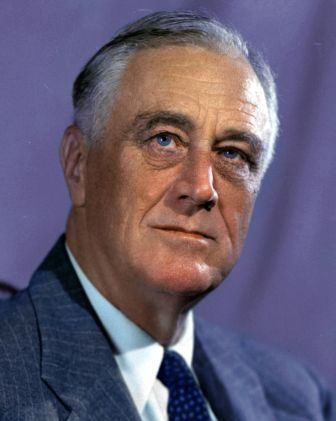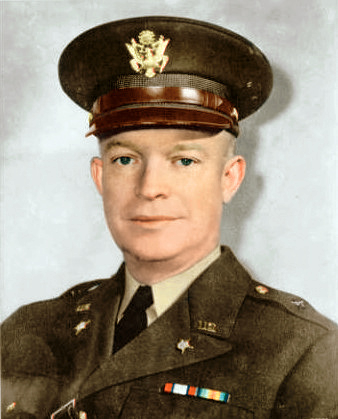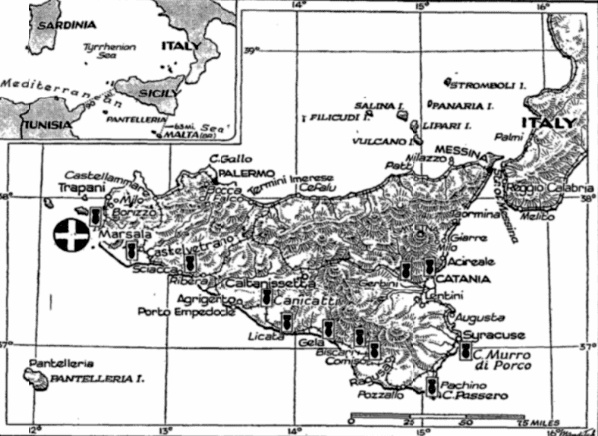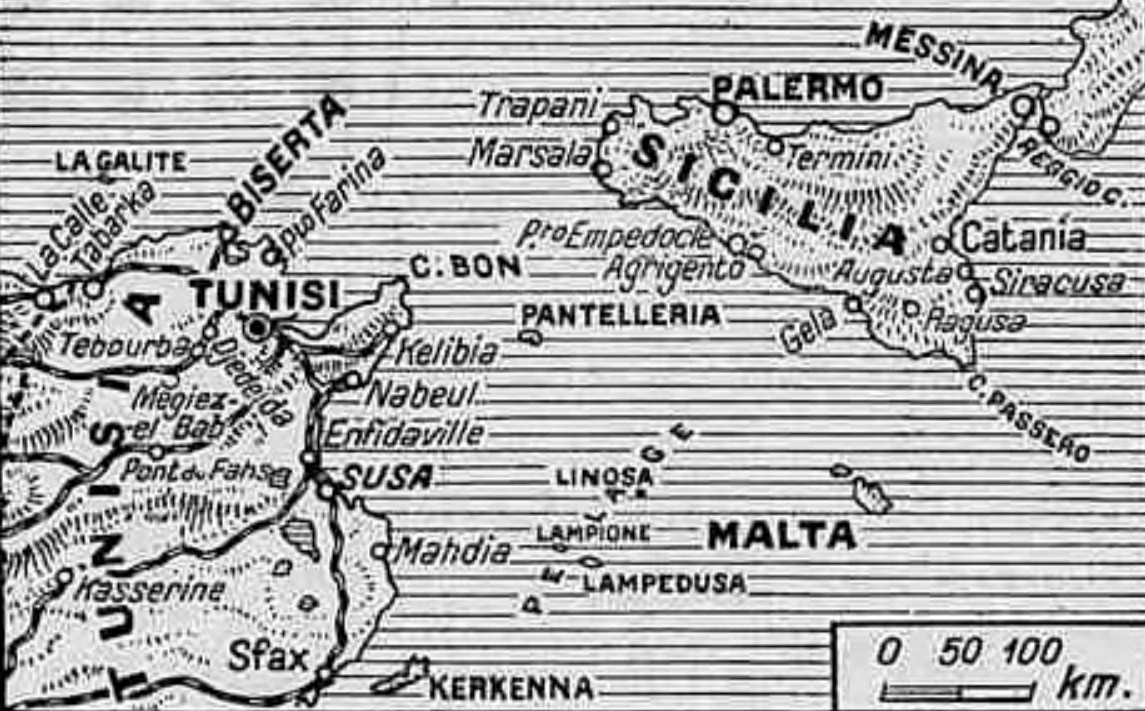Brooklyn Eagle (July 10, 1943)
300,000 give stiff battle as Allied army pours in
Invasion theater
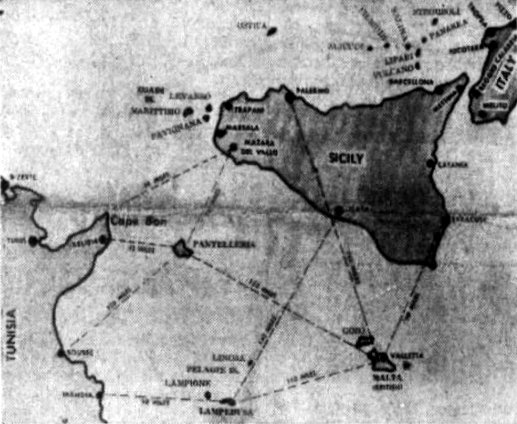
Allied forces were battling on Sicily today after crossing the Mediterranean bottleneck from North Africa. Landing forces traveled varying distances – 88 miles from Cape Bon and up to 150 miles from other Tunisian coast towns – and probably also came from Pantelleria, 70 miles away, and Malta, 80 miles from the nearest point in Sicily.
Allied HQ, North Africa (UP) –
The United Nations opened the battle of Europe today by sending powerful invasion forces swarming onto the beaches of Sicily, and the first eyewitness report said a bombardment by Allied warships had “started a chain of smoke and flames” stretching 10 miles into the island.
A mighty aerial umbrella aided the Allied invasion forces which were made up of U.S., British and Canadian troops. Meager and unofficial reports said the invasion aided by heavy naval support was “proceeding according to plan.”
Indications were that the Axis defenders were putting up a stiff fight.
Axis communiqués reported that the fighting was heavy on the southeastern coast of Sicily, and said decisive counterblows had been struck against the invaders. British sources suggested other and more important blows might be struck against the fortress of Europe soon.
The Allied amphibious operations under command of Gen. Dwight D. Eisenhower began after two weeks of mounting aerial onslaught that was continued by hundreds of airplanes up to yesterday, when U.S. Liberators from the Middle East smashed Comiso and Taormina, 30 miles south of Messina, causing heavy damage.
Fifteen Axis planes were shot down yesterday when Allied aircraft from the Northwest Africa Command encountered increased opposition, losing 10 airplanes.
A furious naval barrage that illuminated sections of the Sicilian coast opened the invasion operations in darkness as the Allied meet – including battleships – threaded through the enemy minefield and put assault troops ashore in tank-carrying barges. There was no immediate indication that Mussolini’s scattered and battered Italian fleet accepted the challenge to fight the invasion.
Designed to establish bridgeheads
The first phase of the attack on Sicily, regarded popularly as the opening move in establishment of a second front, was designed to establish bridgeheads, and strong Axis opposition was anticipated in the air and on the ground.
London reports describing the greatest Allied offensive of the war suggested that parachute and airborne troops were used by the Allies to crash through the strong Sicilian defenses, manned by an estimated 300,000 Italians and Germans. Radio Morocco reported the landings were “being consolidated” on the west coast of Sicily, but it was believed many landings had been made around the shores of the island, with the ports of Catania, Palermo and Trapani as well as Comiso, Catania and Gerbini Airdromes as the main objectives.
The reported landing at the western tip of Sicily indicated that the first Allied objectives included the important Axis air bases of Trapani, Marsala, Mazzaro, Milo and Castelvetrano, all on the western end of the island and are linked by a network of good roads with the big port of Palermo.
The Allied invasion forces, specially trained in American-built landing barges for many weeks, were reported meeting “strong resistance” in the first phase of fighting on European soil just two months after the last Axis forces were driven from Africa.
The special communique at 5:10 a.m. from Allied Headquarters said:
Allied forces under command of Gen. Eisenhower began landing operations on Sicily early this morning. The landings were preceded by Allied air attack. Allied naval forces escorted the assault forces and bombarded the coast defenses during the assault.
The crossing of the 90-mile “moat” from Tunisia to the rugged island of Sicily, which once had 4,000,000 population, was made in all types of naval craft, including special landing barges brought under their own power from the United States to strike at Italy just three years and one month after Mussolini stabbed France in the back.
There was no mention of French troops taking part in the invasion of Sicily.
For two weeks huge Allied air fleets based in Northwest Africa and the Middle East had hammered at Sicily with thousands of tons of bombs, seeking to knock out Axis air power, demolish air bases, destroy railroad facilities and’ ports and isolate the island from the Italian mainland. For the last seven days the air attack had been almost continuous, day and night.
Then the converted freighters, the big battleships, the fast destroyers, the heavily armed cruisers and the new type landing barges – heavily armed and heavily protected – were assembled by the hundreds and put out in darkness from the African coast. Crouching in the barges and jammed aboard the transports were U.S. troops that had been practicing invasion assaults for weeks and were toughened and ready for the hardest battle of their lives.
There were Canadian troops, too – the rough-and-ready soldiers who had been waiting (presumably until recently in England) for the chance to avenge their comrades who fell at Dieppe and had long been promised the honor of spearheading the invasion of Hitler’s European fortress.
The British forces, which chased Nazi Marshal Erwin Rommel across Africa and into the sea, were the third part of the Allied team which struck at Sicily in an, operation that found land, sea and air forces cooperating magnificently under Eisenhower’s command.
Crouched in the landing barges, with their heads tucked down against their shoulders turtle-fashion, the Allied troops led by engineers and sappers were off the Sicilian coast in the dark hour before dawn came over the Mediterranean.
The engineers, given the toughest job in such a hazardous operation, carried Bangalore torpedoes – a gadget about 15-18 feet long and encased in a two- or three-inch pipe – used to shove into barbed wire entanglements in order to blast open a path for the assault troops.
Big guns open up
Allied force from Malta, only 60 miles from Sicily, were presumed to have joined the invasion units somewhere off the island coast.
And then, in the last period of darkness, the big guns of the naval armada opened up.
The guns flashing out in the darkness may have been the first sign that the nervous Axis defense forces received that the battle to knock Italy out of the war had begun. But the enemy had been predicting the assault for days, reporting the massing of Allied troops and barges and trying desperately to guess where the first blow would fall.
Although the steady pounding of Allied airplanes had knocked out the main Sicilian harbors closest to Italy, there were late reports that Nazi and Fascist reserves had been rushed to the island and there was little question that the struggle for the mountainous stronghold would be a costly and probably a long one.
Resistance fierce
Preliminary reports indicated Axis resistance was fierce and that enemy airplanes were attacking desperately, often diving through their own anti-aircraft fire in their efforts to get at Allied bombers.
Field Marshal Albert Kesselring, the Nazi air expert who had commanded an air fleet on the Russian Front, was reported directing the Axis aerial defenses with the aid of Baron Wolfram von Richthofen, who had also been on the Eastern Front.
The Axis reaction by radio was also slow. The first Axis word of the invasion came from the German Transocean News Agency in a dispatch datelined “London.” It said that according to an official announcement Allied forces had started landing operations in Sicily. The same agency next flashed a Washington announcement of the landing. Berlin radio later repeated the news.
Radio Vichy told the people of France that the Americans had made “important” troop movements for an imminent invasion of Sicily.
The first great Allied assault against the European fortress was started after a coldly, scientific day-and-night aerial bombardment that accelerated steadily for two weeks.
Air assault hits crescendo
As the aerial assault reached a crescendo, fighters and fighter-bombers in large numbers joined in the attack to shoot up Axis trucks and railroad equipment in order to hinder or halt the movement of enemy forces when the invasion began.
Radio Algiers, broadcasting to Italy, said that:
The Battle of Africa is ended and the Battle of Europe has begun. The warnings of President Roosevelt and Prime Minister Churchill have come true. Italy, dragged by Mussolini into Hitler’s war, has become a battlefield. The German rearguard action is being fought on Italy’s soil.
